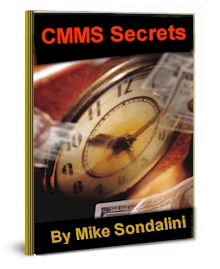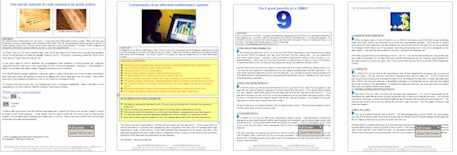CMMS Secrets
By Mike Sondalini
 The value in the "CMMS Secrets" white paper is that ...
The value in the "CMMS Secrets" white paper is that ...
For obvious reasons, this experience and knowledge are unknown (a secret) to the end user first exploring the purchase and implementation of CMMs software. What Mike Sondalini has written is very forward thinking that is blindly obvious to in-the-field maintenance practitioners but totally missed by CMMS implementers in the office. (12 pages)
The valuable insight in this white paper is just as important to those designing CMMS software. Mike Sondalini sums it up nicely...
"If they do what I have written about they will get a lot of early success in their implementations."
Gain valuable insight and understanding; get your copy of CMMS Secrets PDF today!
![]() Download right away in a printable PDF format!
Download right away in a printable PDF format!
$12.50

CMMS Secrets Table of Contents
Components of an effective maintenance system.
If you are ever in the fortunate position of developing a maintenance system from the beginning, the list in this section will help you focus your efforts. Maintenance systems in small businesses, develop by default and without much forethought. This list puts together, in one place, the important components of a workable maintenance system.
Equipment identification tags save time.
Identifying equipment for operators and tradesmen will save time, reduce errors and promote accurate record-keeping. Equipment identification involves putting a unique number and a unique written description onto a machine.
The 9 great benefits of a CMMS.
A computerized maintenance management system (CMMS) is the maintenance department's most important tool. It provides insight into the behavior of the facility's individual assets, i.e. the plant and equipment. For a CMMS to be of use it must be used as an information 'bank' that can be investigated. There are 9 really good reasons to use a CMMS. And each one of them alone makes a CMMS worth having.
Valuable secrets in every work order report.
The book "MAINTENANCE PLANNING AND SCHEDULING HANDBOOK" by Doc Palmer and published by McGraw Hill presents the recommended way to plan for a maintenance crew. As reviewed by Mike Sondalini.
Job types on work orders.
Historically numbers have been used to represent the work type. As numbers are not a universal human method of describing the work type is also described using words. The proper choice of words is critical if classification errors are to be minimized.
Job descriptions tell tradesmen what to do.
The first words a maintainer will read when they pick up a work order is the job description. The job description must tell him enough information about the work so he can understand what to do.
Use written work instructions.
Job procedures or job instructions are written directions given to equipment maintainers. They reduce the chance of making an error and reduce the time spent looking for information. Job instructions offer an opportunity to ensure a job is well-planned, well-documented, and well-organized. Once written they are reused forever more.
Use words on work orders instead of code numbers.
A work order full of code numbers confuses people. When the work order type (breakdown, corrective, modification, etc) is described as Work Order Type '04' you can guarantee that no one knows what '04' is without looking it up on a list. The best way to prevent confusion is to use word descriptors.
Related downloads ...
The CMMS Selection & Specification KIT
Please Tap Contact BIN95 here to contact us with your questions and comments.
